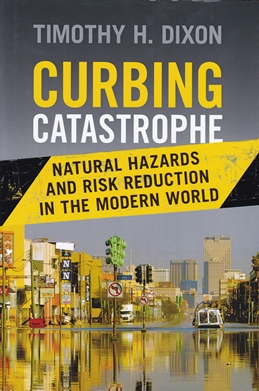Curbing Catastrophe: Natural Hazards and Risk Reduction in the Modern World
 Natural hazards and risk reduction are such broad topics that any attempt to squeeze them into a single volume should backfire. It would certainly be impossible to cover the full topic in any depth. The author is a Professor in the School of Geosciences and Director of the Natural Hazards Network at the University of South Florida. He uses satellite geodesy and remote sensing data to study earthquakes and volcano deformation, coastal subsidence, groundwater extraction and glacier motion. With this background one would expect the focus to be on the technical and scientific aspects of the hazards. However, this book actually covers these topics lightly. The level of detail is generally below that of undergraduate studies, and is really just to get non-technical readers up to speed ready for the main topics in the book: The importance of communication, the importance of understanding long-term processes, and the economic consequences of failure.
Natural hazards and risk reduction are such broad topics that any attempt to squeeze them into a single volume should backfire. It would certainly be impossible to cover the full topic in any depth. The author is a Professor in the School of Geosciences and Director of the Natural Hazards Network at the University of South Florida. He uses satellite geodesy and remote sensing data to study earthquakes and volcano deformation, coastal subsidence, groundwater extraction and glacier motion. With this background one would expect the focus to be on the technical and scientific aspects of the hazards. However, this book actually covers these topics lightly. The level of detail is generally below that of undergraduate studies, and is really just to get non-technical readers up to speed ready for the main topics in the book: The importance of communication, the importance of understanding long-term processes, and the economic consequences of failure.
The book is based around case studies from the author's personal experience including the New Orleans flooding, the Haiti earthquake, the Fukushima nuclear accident, and climate change. Each case study is simply a medium for demonstrating failures in the main topics of the book and so are covered in mixed levels of detail, occasionally delving deep into areas of particular interest. Written in an easy-to-read narrative style, each story is presented in a compelling way that makes this book a genuinely enjoyable and thought-provoking read.
Recommendations are made throughout the book for scientists, engineers and politicians ranging from scientific communication to tax policy. Professor Dixon gives fantastic examples from his own scientific papers, showing how the cautious use of language in science communication blunts the message to the point where it becomes easy to ignore, and gives numerous examples of societal own-goals where poor planning is subsidised by taxpayers and a false sense of security is given to the people living in at-risk zones.
If you want to learn about the science of natural hazards, there are better sources. If you want to learn about communication of science and risk, or setting policy to reduce risk, this book with be invaluable. You’ll take an entertaining and informative ramble through topics ranging from risk theory, the amount of caesium in wine, how vested interests bias the public discourse, the impact of building codes on fire safety, and the importance of companies confessing their errors openly and rapidly. This book will open your eyes.
Reviewed by Ross Roberts
CURBING CATASTROPHE: NATURAL HAZARDS AND RISK REDUCTION IN THE MODERN WORLD by TIMOTHY H DIXON, 2017. Published by Cambridge University Press 33pp ISBN: 978-1-107-03518-8 List Price: £21.99 W: https://www.cambridge.org/core/books/curbing-catastrophe/02789220833AB1F54C51B9D0628E639C